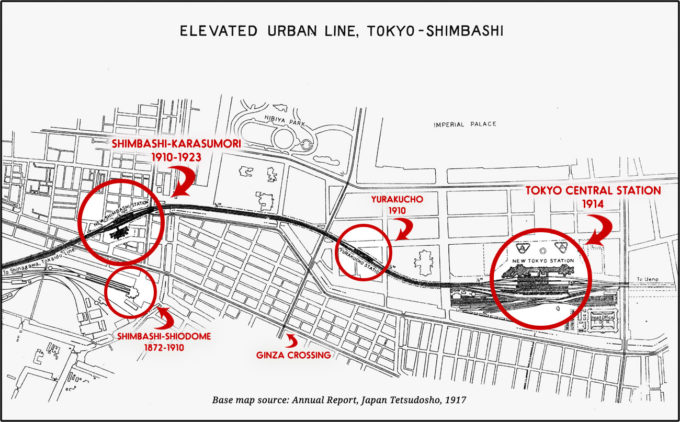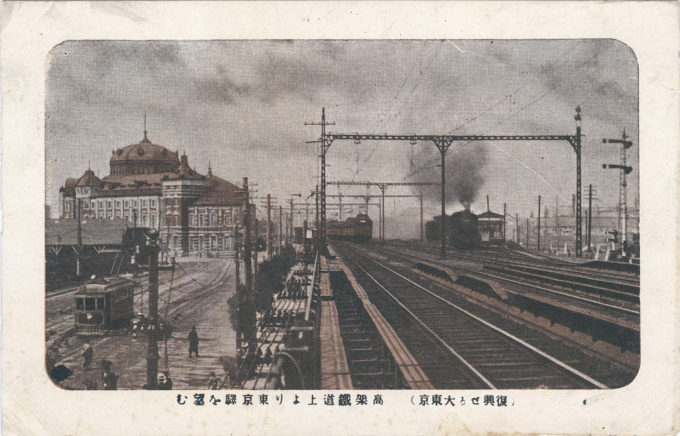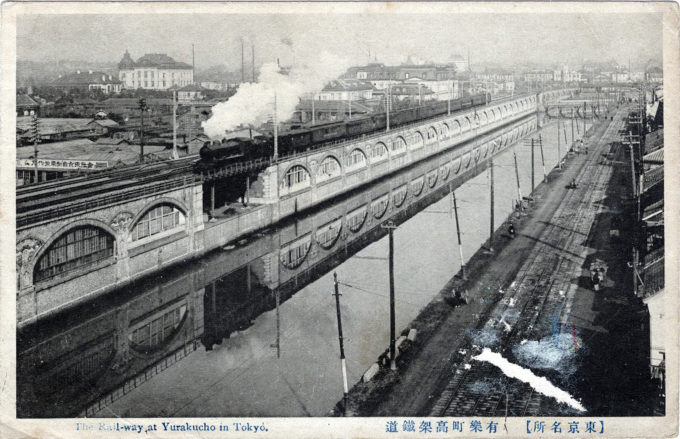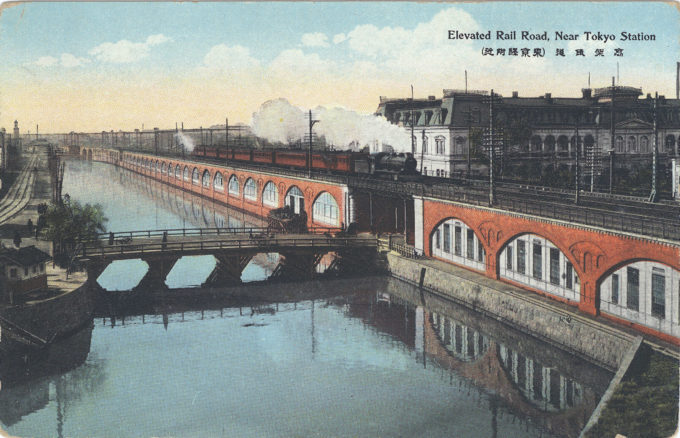
“Elevated Rail Road, near Tokyo Station”, Tokyo, c. 1920. The Tokaido Main Line steams past the Imperial Hotel (1890-1923) and Yamashitabashi on its approach to Tokyo Central Station.
See also:
Yurakucho (Tokyo) Station opening, 1910.
Shimbashi Station (Kasumori), c. 1910-1923.
“The construction of the proposed metropolitan elevated railway of Tokyo from Shimbashi to Uyeno, for which the necessary appropriation was granted by the Diet in the 28th year of Meiji (1895), has lately been actually taken in hand.
Map: New stations along the elevated urban railway between Tokyo-Shimbashi (Karasumori) ca, 1917, constructed between 1910-1914. [Base map source: Annual Report, Japan Tetsudosho, 1917.]
“… Between Saiwaibashi and Yamashita-mon the new four-track brick viaduct will be erected along the moat, passing close on the eastern side of the Imperial Hotel; where the execution of some earthworks is now going on, the high embankments and stone walls of the moat having been removed in order to make room for the foundation of the big viaduct piers.
“Besides the Central Station which is proposed in Yurakucho north of Kajihashi and the City Hall building, a new elevated station is to be built in the Karasumori district about opposite to Shimbashi-Shiodome, and one more for local traffic only in Yurakucho north of Sukiyabashi.”
– Japan Daily Mail, November 24, 1900
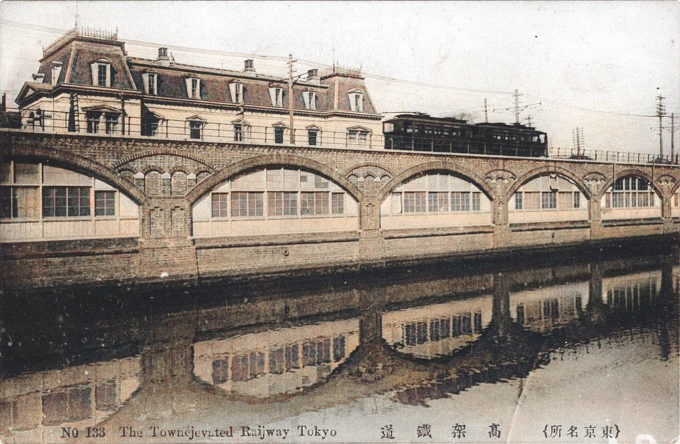
“The elevated railway”, Tokyo, c. 1920. Two commuter carriages of the Yamanote Line pass by the Imperial Hotel on the elevated railway.(Colorized)
“It was as far back as 1889 that the idea of building an overhead line through the city of Tokyo, to serve as the direct chord between the two metropolitan termini — Shimbashi and Ueno — was conceived as part of the street improvement plan of Tokyo.
“The idea became one of practical importance, when the steady growth of traffic on the lines serving the metropolis, particularly the Tokaido and the North – Eastern, began heavily to tax the poor capacity of the Yamate Line, which forms the sole link connecting the two foregoing lines, not to mention the fact that the two stations were found wholly inadequate to cope with the present and prospective development of traffic. The undertaking was started, and as a first step it was decided to lay a deviation from Shimbashi station (the then-terminus of the Tokaido Line), and to make arrangements for the construction of a central station in the heart of Tokyo.
Yamanote Line (center) and Tokaido Main Line (right) trains leaving Tokyo, c. 1930, on the elevated track built between Tokyo Central Station and Shimbashi-Karasumori Station constructed between 1910-1914.
“Towards the end of 1899 the purchase of land was taken in hand, but unfortunately the undertaking was repeatedly postponed, or even suspended, for want of funds, and it was more than a decade before the first section of the line was finished.
“In the interim, the electrified section of the Yamate Line, described elsewhere, was extended to Karasumori (the name of which has been changed to Shimbashi) in 1909, to Yurakucho in June, 1910, and in September to Gofukubashi, a temporary station adjacent to the projected Central station. In December, 1914 the construction of the Tokyo Central station was finished, and the station was opened for service. Simultaneously with the opening of the new line, the Shimbashi station was turned into a goods depot and its name changed to ‘Shiodome.’
“… The elevated urban line is one of quadruple track, two of which tracks are used for suburban, and the other two for through-train service. Both groups of tracks were originally designed for steam trains, but, in view of the prospective growth of traffic, the quadruple track plan was, later on, changed to the sextuple … At present, two tracks only are electrified, the other two being reserved for the operation of steam trains. The tracks are carried on masonry and steel viaducts, concrete or brick arches spanned between masonry piers being the standard construction , with steel plate girder structures supported on steel columns for the street subways.
“A further extension of the overhead line leading north to Manseibashi and Ueno stations is now under construction. The line will carry 6 tracks between Tokyo and Kajicho, 2 tracks between Kajicho and Manseibashi, and 4 tracks between Kajicho and Ueno. A separate goods line will also be laid leading to the present metropolitan goods depot at Akibahara.”
– Annual Report, Japan Testsudosho, 1917


